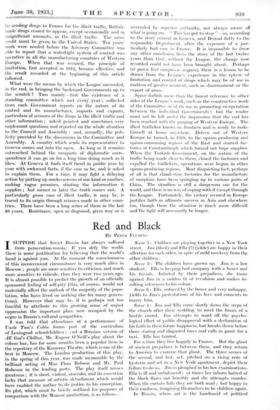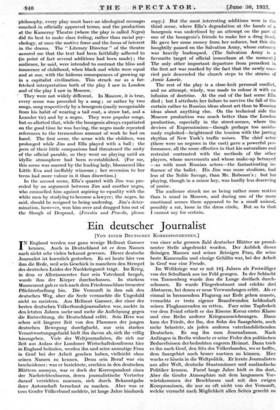Red and Black
By PETER FLENI 1NG SUPPOSE that Soviet Russia has always suffered 1. from persecution-mania. If you defy the world, there is some justification for believing that the world's -hand is against you. At the moment the consciousness of this inconvenient circumstance is very much alive in Moscow ; people are more sensitive to criticism, and much more sensitive to ridicule, than they were two years ago. It is almost possible to predict the growth of an officially sponsored feeling of self-pity (this, of course, would not materially affect the outlook of the majority of the popu- lation, Who have lived on nothing else for many genera- tions. However that may be, it is perhaps not too fanciful to attribute to this growing sense of unjust oppression the important place now occupied by the negro in Russia's cultural sympathies. I was told that. attendance at a performance of Uncle Tom's Cabin forms part of the curriculum of Leningrad schoolchildren ; r nd a Russian version of All God's Chillun, Mr. Eugene O'Neill's play "about the colour bar, has for some Months been a poptilar item in the repertory of the Kamerny Theatre, which is one of the best in Moscow. The London production of this play,. in the Spring of this year, was made memorable by the brilliant acting of Miss Flora Robson and Mr. Paul Robeson in the leading parts. The play itself misses greatness ; it is short, violent, staccato, and its execution lacks that measure of artistic detachment which would have enabled the author to do justice to his conception. Its plot, 'which must be briefly outlined for purposes of comparison with the Moscow production, is as follows : Seem; 1: Children are playing together in a New York street. Jim (black) and Ella (?) (white) are happy in their affection for each other, in spite of mild mockery from the other children.
Scene 2 : The children have grown up. Jim is a law student. Ella is keeping bad company with a boxer and his friends. Infected by their prejudices, she turns against Jim in a sudden fit of revulsion and makes in- sulting references to his colour.
Scene 3 : Ella, seduced by the boxer and very unhappy, yields to Jim's protestations of his love and consents to marry him.
Scene 4 : Jim and Ella come slowly down the steps of the church after their wedding, to meet the hisses of a hostile crowd. Jim attempts to ward off the psycho- logical effect of public disapproval with a declaration of his faith in their future happiness, but breaks down before those staring and disgusted faces and calls in panic for a taxi. Ella has fainted.
For a time they live happily in France. But the ghost of ancient prejudices is between them, and they return to America to exorcize that ghost. The three scenes of the second, and last, act, pitched on a rising note of hysteria and set in a New York apartment, depict their failure to do so. Jim is ploughed in his law examinations. Ella is ill and unbalanced ; at times her inborn hatred of the black flares out horribly and she attempts murder. When the curtain falls they are both mad ; but happy in their madness, imagining themselves to be children again.
• In Russia, where art is the handmaid of political philosophy, every play must have an ideological messages • couched in officially approved terms, and the production at the Kamemy Theatre (where the play is called Negro) • did its best to make class feeling, rather than racial psy- chology, at once the motive force and the focus of interest - in the drama. The "Literary Director" of the theatre -assured me that the text had been faithfully adhered to (in point of fact several additions had been made) ; the audience, he said, were intended to contrast the bliss and innocence of childhood, when black and white were equal and at one, with the hideous consequences of growing up in a capitalist civilization. This struck me as a far- fetched interpretation both of the play I saw in London and of the play I saw in Moscow.
• They were not widely different. In Moscow, it is true, every scene was preceded by a song ; or rather by two songs, sung respectively by a bourgeois (easily recognisable from his habit of wearing a tail coat, a straw hat, and a Leander tie) and by a negro. They were popular songs, but so allotted that, while the bourgeois always expatiated on the good time he was haying, the negro made repeated references to the tremendous amount of work he had on hand. The first scene, the scene with the children, was prolonged while Jim and Ella played with a ball ; the jeers of their little companions had threatened the unity of the official parable, so they went on playing until an idyllic atmosphere had been re-established. (For me, this scene was marred by the leading lady, bloomered like Little Eva and ineffably winsome ; her reversion to her teens had more -valour in it than discretion.) • In the second scene, Ella's quarrel with Jim was pre- ceded by an argument between Jim and another negro; who counselled him against aspiring to equality with the white men by studying to become a lawyer; the negro, he said, should be resigned to being underdog. Jim's deter- mination, however, won him over and dragged him out of the Slough of Despond. (.Izvestia and Pravda, please copy.) But the most interesting additions were in the third scene, where Ella's degradation at the hands of a bourgeois was underlined by an attempt on the part of one of the bourgeois's friends to make her a drug fiend. He gave her some money from her seducer, but this she haughtily passed on the Salvation Army, whose entrance was heavily burlesqued. (The Salvation Army is a favourite target of official iconoclasm at the moment.) The only other important departure from precedent in the first act was _marked by. the fact that the newly mar- ried pair descended the church steps to the strains of Annie Laurie.
The rest of the play is a close-knit personal conflict, and no attempt, wisely, was made to colour it with an infusion of doctrine. At the end of the last scene Ella died ; but I attribute her failure to survive the fall of the curtain rather to Russian ideas about art than to Russian ideas about anything else. On the technical side the -Moscow production was much better than the London production, especially in the street-scenes, where the devices of Expressionism,—though perhaps too assidu- ously exploited—heightened the tension with the jarring rhythm of New York's traffic noises. The chief actor .(there were no negroes in the cast) gave a powerful per- formance, all the more effective in that his naturalism and restraint contrasted with the methods of the other players, whose movements and whose make-up betrayed —as with most Russian actors—the fantasticating in- fluence of the ballet. His Jim was more studious, had less of the Noble Savage, than Mr. Robeson's ; but his playing, though in a minor key, was hardly less deserving of praise.
The audience struck me as being rather more restive than is usual in Moscow, and during one of the more emotional scenes there appeared to be a small animal, possibly a rat, loose in the dress circle, But as to that I cannot say for certain.











































 Previous page
Previous page